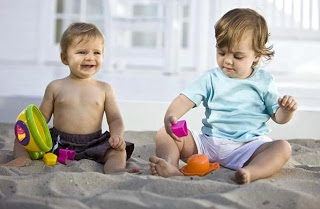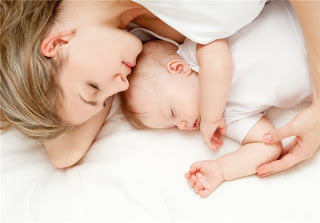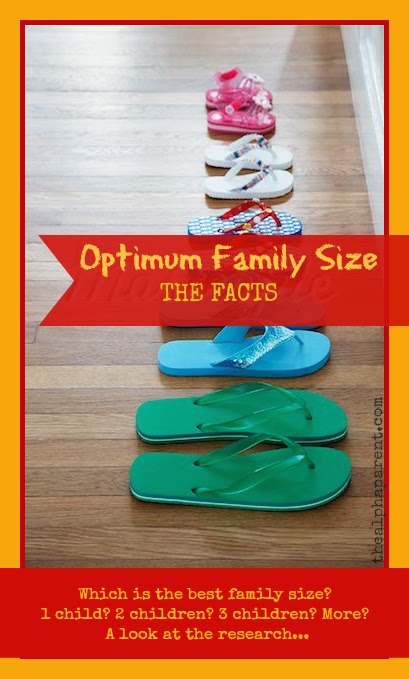
How many children should I have? It’s the question that plagues many of us breeders. Some never fully resolve the budding uncertainty of the “What If…” conundrum. What if I have just one more? What if I stop at the traditional two? What if I don’t give my child any siblings at all? This article will help to alleviate those concerns using leading sociological, economical and even physiological research.
1 CHILD:

The pros:
- The percentage of women having only one child has nearly doubled over a generation (Kelley 2007). In fact, only children are America’s fastest growing family demographic (Hass 1999) so your kid will not be as unusual as they would have been a generation ago. Much of the stigma has been consigned to history (Blair 2013).

- Only-children tend to have a higher proportion of successes in life and that they tend to have higher I.Q.’s than any other family setup (Goleman 1985).
- Parents outnumber children.
- Your existing house/flat is likely to be big enough to accommodate all the necessary parenting paraphernalia.
- Ditto the car.
- Childlessness aside, this is the most environmentally-friendly family setup.
- A single child family permits the most rapid reconnection with a pre-natal lifestyle; at work, at home and socially, if that’s important to you (Brazier 2013).
- Your child will never be forced to share parental care and attention.
- As a result of seldom-interrupted adult interaction, only-children often become articulated, surprisingly-mature little characters.
- Only-children tend to do well in school, both because they’re able to express themselves clearly and well and because they’re used to and skilled at interacting with adults (Blair 2013).
- Only-children are able to amuse themselves happily and to spend significant amounts of time alone.
- You will be able to afford to give your child more educational opportunities. In fact, only children are likely to get three years more education than a child from a family of six (Goleman 1985).

-
- No sibling rivalry.
- Your child is likely to be taller than their siblinged peers (Lawson and Mace 2008).
- Only-children tend to have a logical and organised mindset (Blair 2013). Because they grow up primarily around adults, only-children are more used to expecting a logical transaction when they interact with people. They never have to put up with siblings who threw tantrums, nor are they regularly forced to abandon logic to argue jealously with them.
- No inheritance squabbles when you die.
The cons:
- Only-child families are often the recipients of stigma (Yoder 1999).
- Your kid is more likely to be a fatty. In fact, being an only child is seen as one of the ‘most significant’ causes of obesity in children (Wang et al 2007; Padez et al 2005; Pearce et al 2009; Winkinson 1977).

- Some studies suggest that only-children can feel pressured, overprotected or, worst of all, come to doubt their own capabilities or their parents’ sincerity (Blair 2013).
- Only-children can feel as though they are living their lives for their parents rather than for themselves (Blair 2013).
- One-child families have a higher than normal incidence of ‘emotional incest’. With no other child to dilute the intensity of the parent-child bond, everything about the only-child is watched closely, including his health, physical development, school performance, talents, weaknesses, and achievements. All the parents’ worries, wishes and dreams are channelled into one offspring (Adams 2011).
- Some commentators suggest that your experience of the ‘terrible-twos’ will be harder. The theory is that siblings generally have a lower tolerance of rebarbative behaviour in a child than that child’s parents. A child, arguably, can get away with less if a sibling is on the scene. The essence of this argument could be said to extend well beyond the terrible twos (Brazier 2013).
- Be forewarned, this bullet point is going to sting: Only-children tend to be more disruptive, get into more fights, make friends slower and keep them for shorter. They find it more difficult to ‘get along with people who are different’. They are less empathetic and poor at comforting and helping other children. They are less upbeat than their siblinged counterparts. They are also worse at ‘respecting the property rights of others’ and poor at soaking-up pressure. In a word, they are less ‘emotionally-intelligent’ (Downey and Condron 2004).
- Although parents of an only-child usually make enormous efforts to provide their child with plenty of opportunities to socialise with their peers, these interactions will be fairly circumscribed. They’re likely to have been planned, time-limited, and supervised by adults. This means their child misses out on learning the skills needed to establish ‘territory’ without an adult there to sort things out for them, to stand up for themselves diplomatically and find ways to share limited toys or space (Blair 2013). However this deficit appears to be overcome by adolescence (Zeher and Downey 2013).
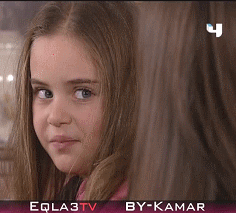
- If your child is bullied at school, they are without a main source of support. A British study from the Economic and Social Research Council has found siblings to be an important and invisible source of support for children who are bullied in everyday life, including school (Hadfield et al 2006).
- Being practical and sensible and wanting to do everything as expertly as possible predisposes only-children to unhealthy perfectionism. It is natural for every child to compare themselves to those around them. Given that there’s usually a preponderance of admiring and encouraging adults in the only-child’s life – throughout childhood – it means they set their standards in relation to them (Blair 2013).
- Only-children find it difficult to tolerate disorder. When things in their life fall into disarray, there is usually an adult on hand to sort it out, more or less straight away. That means the only-child will grow up with little, if any, experience of coping with disorder and confusion, particularly lasting disorder and confusion. When an only-child finds themselves in a disordered situation later as an adult they can feel anxious and afraid. They fear the loss of control and predictability they’ve been accustomed to (Blair 2013).
- There is some evidence to suggest that children benefit from the experience of having an opposite-sex sibling. This is known as ‘gender complementarity’. Whilst having more than one child doesn’t guarantee a gender split, having just one child completely rules it out (Brazier 2013).
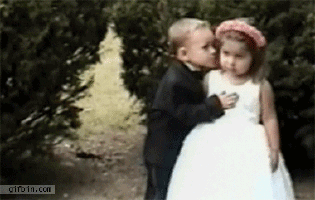
-
- Adults who grew up as an only child were least likely to marry. Those who do marry are the most at risk for divorce than adults who grow up with at least one sibling (Bobbitt-Zeher et al 2013).
- You’re more likely to get divorced than other parents. Rates of divorce among only-child mothers are twice that of women who have two to four children (Falbo 1978 – recent research is needed to ascertain whether this is the case contemporarily; the climb in modern divorce rates would suggest so).
- If you get divorced, your child is less likely to cope as well as their siblinged peers. Studies have shown that only-children demonstrate the most serious adjustment problems during their parents’ divorce (Forehand et al 1991).
- When you grow senile and need eldercare, this places a huge burden upon your only child. It seriously stunts their geographic mobility and labor market outcomes (Rainer and Siedler 2005).
- There’s no other way to put this one: If the worst happens and your child dies, you will be left childless. One report from Denmark, for instance, showed that when a child dies, parents are significantly more likely to die themselves from unnatural causes; accidents and suicide. A 2005 study showed that parents who lose a child are at greater risk of ‘extreme emotional loneliness and severe depressive symptoms’, including suicide (Stroebe et al 2005; Li et al 2005). Divorce rates among bereaved parents are up to eight times the norm (Lehman et al 1987). Couples are less likely to split if they have older children living at the time of death (Rogers et al 2008). Remember furthermore, there are also other types of ‘loss’. An only child who responds to the opportunities of globalisation by moving abroad, will leave parents with no proximate sibling (Brazier 2013).
2 CHILDREN:
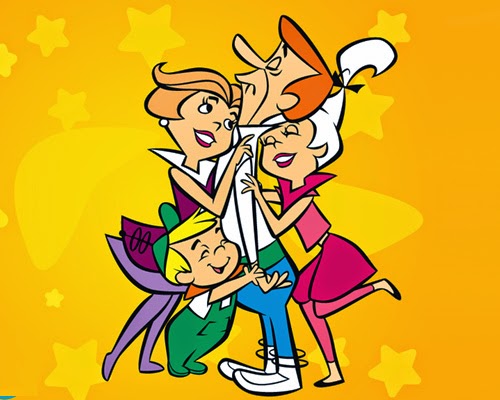
The pros:
- This is the most popular family size (Frejka et al 2008). Consequently, most ‘family ticket’ deals for restaurants, flights, themeparks et al, are designed specifically for this ‘two adults, two children’ family setup.
- This is the magic number for your happiness, according to a recent study (Myrskylä and Margolis 2014). The research tracked British and German parents through the journey of parenthood and found that after 2 kids, the feel-good novelty wears off and the stress levels rise.
- With this size you have a perfect ‘one-to-one’ ratio. Dr Alan Singer, in his book Creating Your Perfect Family Size, has observed that “in families with two children, one parent tends to gravitate toward one child more than the other, and it’s not predictably one sex or another, but varies from family to family” (Singer 2011).
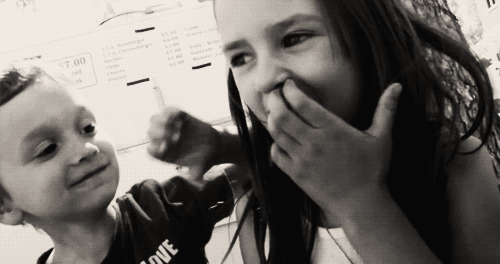
- The elder child tends to take the ‘caretaker’ role whilst the younger child takes the ‘baby’ role, and the traits of each complement one another. The organised and caring first born wants someone to keep in order and to nurture, and the fun-loving but rather less organised and more dependent last born is likely to respond well to this (Blair 2013).
- This is going to sound morbid, but if one of your children were to die, you’d still have a spare one left. In a large-scale American study, a third of mothers and a quarter of fathers said that “Not to be left childless in the case of death of only child” was their chief motivation in countenancing the conception of a second child (Brazier 2013).
- When fights break out, there’s no such thing as “Two (or more) Against One.”
- Your children are likely to be taller than their peers with multiple siblings (Lawson and Mace 2008).
- This family size is thought to be protective against child psychiatric problems (Taanila et al 1992).
- This is a great family size for when your kids grow up. Studies show that adult sibling pairs report more positive feelings towards each other than other sibling alternatives; this is particularly so if you have two girls (Spitze and Trent 2006)
The cons:
- If the two children are twins, conflict is likely. This is because they are both effectively ‘first borns’ and so both want to be in charge, particularly if they are both highly competitive (Blair 2013)
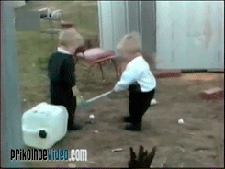
- Firstborns enjoy a higher proportion of successes in later life and that they tended to have higher I.Q.’s than later-born children (Goleman 1985). This means that the younger child is predisposed to insecurity. The effect is more intense when siblings are spaced close together (see here).
- First-borns also receive about 20 more minutes of quality father-time and 25 more minutes of quality mother- time each day at each age than the second-born child does at the same age. Ouch! (Price 2007).
- The youngest child is more likely to engage in ‘risky adolescent behaviour’ such as substance abuse and sexual experimentation (Argys et al 2007).
3 CHILDREN:

The pros:
- Most parents say that it is when child #3 arrives that team work really thrives. Like or or not, it becomes apparent pretty quickly that the two of you will be obliged to work together if you are to keep everything afloat (Cockrell et al).

- The middle child is likely to be highly creative and innovative. There’s an interesting reason for this: from the moment they were born, they had to share their parents with an older sibling, and before too long, with a new baby as well. They lack the advantage of maturity so that means their older sibling can do most things better than they can, and they are no longer the needy and adorable baby. This means that the middle child has to be quite innovative to find ways that will attract and hold their parents’ attention. They carry this creativity through life (Blair 2013).
- For very much the same reasons, the middle child is likely to grow up socially smart – that is, knowing how to draw enough attention to themselves to get what they need, but without annoying others by stealing the spotlight from them.
- This is apparently the best family setup for household wealth, according to a US study (Scholz and Seshadri 2007).
The cons:
- You are now in outnumbered territory.
- Having three children seems to be the tipping point in which parents devote less time to caring for their offspring relative to those with one or two children. However once the youngest child reaches school entry age, this ceases (Craig and Bittman 2005).
- Grandparents are more likely to limit babysitting to one child at a time (due to the aforementioned outnumberedness).
- Bus rides, train journeys, theme parks and any other scenario that requires sitting in pairs will mean separating one child from the rest.
- You are likely to need a bigger car.
- In restaurants you are likely to have to wait for a bigger table.

- Your middle born is more likely to have poorer self-esteem than his siblings, and to believe his parents are more punitive and less loving toward him than to his siblings. He feels as though he is fighting “a constant battle to be heard” (Brazier 2013). These feelings are strongest when the spacing between siblings is about two or three years (Goleman 1985).
- There’s now so much kids’ stuff all over the floor, you think it breeds at night.
- This seems to be the threshold when other people are less forgiving: “Nowadays, people seem to be aghast if a couple wants more than two children” chimed Pamela Paul, in her Washington Post article, aptly titled ‘Three Kids? You Showoffs!’ (Paul 2008).
- The middle child often gets unwittingly pushed into a diplomat’s role. Sandwiched between two siblings who both want things done very much their own way and for their own reasons, the middle child is likely to be the one who proposes a reasonable compromise. Quite often, this compromise would be at his or her own expense, because if someone has to give that little bit more, they will habitually be the one to do so (Blair 2013).
- This seems to be the tipping point where childcare options are concerned. In most families, the amount of work created by three children, and the expense entailed for childcare times three, virtually compels one parent to be at home while the other works (Singer 2011).
4+ CHILDREN:

The pros:
- You can get a tremendous sense of satisfaction from the mini-empire you’re building.
- Less chance of ‘gender disappointment’ – more kids boosts the chances that you will have a mix of genders.

- Children from large families learn to think fast, to read other people’s desires and intended actions (and to take advantage of that knowledge) and stand up for what they believe to be right or what they feel they deserve – without the help of adults (Blair 2013).
- In large families someone’s always knocking over someone else’s carefully arranged set of blocks or deleting their favourite game on the computer, so individuals in these families have plenty of opportunities to figure out what to do when things go into disarray.
- The more siblings a child has, the more socially skilled they will be, and the better they’ll be at getting their way, if they need to, when they’re with other people (Blair 2013).
- From hide-and-seek to tag, games are easier to sustain with more participants, particularly when the ages vary. In fact, ‘play works best in terms of nurturance when those playing are at different stages in childhood’ (Gray 2011).
- The youngest child in a large family is likely to have stellar mental health (Lawson and Mace 2010).
- Large families tend to engage in more physical activity than smaller families, and watch less TV (Crawford 2006).
- Children from large families are sociable and more likely to prefer the company of their peers to being alone (Blair 2013).
- Your children are learning important social skills, such as delayed gratification, because you are not hanging on their every word (Brazier 2013).

- Large families have the lowest risk of experiencing ‘emotional incest’ (see cons of 1 child). In large families, expectations are parcelled out: child 1 can be the achiever, child 2 can be the athlete, child 3 the artist, and so on (Adams 2011).
- When your children grow up and marry, they will be less likely to divorce. In fact, one large-scale study found that the likelihood of divorce is reduced by 2% for each additional sibling that a person has grown up with, wowsa! (Bobbitt-Zeher et al 2013). But wait, there’s a magic number! This increased divorce protection levels off after seven sibs. At this point the gains of big family for training for adulthood seems to have been reached, according to the study.
- If YOU end up divorcing, one large-scale longitudinal study suggests that the negative effects on your children will be mitigated by having multiple sibs (Sun and Li 2009).
- On an even more serious note, some studies have found that large families are less likely to harbour child abuse, in part because siblings act as a kind of surveillance team (Ohlander and Chew 2008).
- Your children are less likely to commit suicide (Denney et al 2009).
- If you’re prehistorically-inclined (read: traditional) more kids means more chance of having a boy and that means more chance of ‘passing on the family name’. Whatevs.
The cons:
- There’s a lot more noise, more chaos, and more work to do. You need more food in the fridge, more diapers changed, more bottles washed, not to mention more brain cells to keep up with the kids, naps, and other stuff.

- This family setup is a killer for your career (Troske and Voicu 2007). In large families, the idea that one parent will be the stay-at-home carer is pretty much a given (Singer 2011).
- People be hatin’. Large families are often the recipients of stigma. They “are presumed to be either really rich, having children as status symbols, or really poor, living off the dole and completely devoid of culture” (Zernike 2009). Ouch!
- You’ll be frowned upon by environmentally-conscious folk and heck, just about everyone (Yoder 1999).
- You will need to trade your car in for a mini-bus.
- The expense!
- One kid brings home the flu and passes it on to another sibling, who then passes it on to another sibling and – you get the idea, permanent illness!

- A high number of siblings dilutes parents’ ability to mould the personality of their children. The 24/7 uber surveillance enjoyed by helicopter-types is nigh impossible with a large brood.
- Unless you’re a multi-millionaire or have saints for extended family, one parent will probably need to give up work permanently in order to care for the brood.
- Women who gave birth to four or more children, are more likely to show signs of cardiovascular disease (Herst 2014).
- There’s now so much kids’ stuff all over the floor, you can’t see the floor.
- Parents are grossly outnumbered by a wild bunch of little people.
- By necessity, you and your partner will need to take time away from being a couple to care for the kids. ‘Your time’ gets folded into ‘family time’ and you can begin to lose the sense of being a couple.
- Mom is at a significant increased risk of cervical cancer: more kids – more risk (NHS 2013).
- Suddenly, everything turns into a production line: getting everyone dressed, juggling nap times, feeding, playtime routines, etc.
- You’ll have to schedule everything from meals to bathroom time (Singer 2011).

- More children means less time spent with each of them, which makes it less likely that each child will have their needs met promptly. The effect of this is that children of larger families – and in particular, the middle borns – will be less likely than others to ask that their own needs and desires are addressed (Blair 2013).
- Less time spent with your children individually means your Guilt Circuit goes into overdrive.
- You will need a people carrier or similarly large vehicle.
- Your kids are more likely to be shorter than their peers (Lawson and Mace 2008).
- Being in public will occasion more than a few side-eyes. Tolerance of the noise and anarchy which come with a large brood will be tested in anywhere but the most child-friendly of places.
- Eating out can be extremely difficult as not many restaurants will have a big enough table.
- After a long, hard day with a large family, there are two choices in front of you: sex and sleep.. Do I even need to finish this sentence?
- More siblings – more allergies. The theory is that the more children a woman has, the fewer antibodies she passes to her unborn babies via the placenta so decreasing the chances of later babies developing an allergy later in life (Karmaus et al 2004; Jarvis et al 1997). Although some studies have questioned this.
- It’s a cruel irony that as the workload and chaos increase, and your need for help escalates, the resources dry up. The once overbearing grandparent presence in your life comes to a screeching halt and potential babysitters are frightened away, Granny and Grampy for instance (Coall et al 2009).
- There is likely to be a lot of squabbling and differences of opinion as each child tries desperately to distinguish themselves from their brothers and sisters (Blair 2013).
- For the same reason, the younger children in particular are more likely to be little hooligans, sorry, it’s true. Because their older siblings have already become competent in most, if not all, of the conventional (and safe) ways, that leaves the youngsters with no choice but to break new ground in order to get noticed. The youngest of a large brood tend to be rebellious, and more likely than others to challenge authority (and take risks). It is children’s nature to push against and test the limits that have been set for them, and this, coupled with the fact that parents tend to relax the boundaries with each successive child, means that the youngest children push against the widest limits – and therefore seek out the riskiest options (Blair 2013). It doesn’t get better when they age. In a study of close to 5,000 adult alcoholics and nonalcoholics it was found that there were disproportionate numbers of last-borns from large families among the alcoholics (Goleman 1985).
- The negatives just keep rolling in for the youngest of large families. These last borns are vulnerable to low self-esteem and to feelings of inferiority. Everyone around them is bigger, stronger and more competent than them. They may even see themselves as ‘behind’ from the start. It’s natural for children to measure themselves against their competitors (namely, their older siblings). Essentially, what gives their older siblings their advantage – their age and experience – is something the youngsters can’t control in any way, and this makes them feel helpless (Blair 2013; Lawson 2013).
- When you finally shuffle off this mortal earth, your kids’ inheritance will be split many ways, and thus likely to be tiny and inconsequential – unless you’re Donald Trump in which case ignore this bullet point, and the one about uni fees.
- Aside from the inheritance scenario, your kids are just generally more likely to be poor when they grow up. Sorry about that (Keister 2003; Keister 2004).

- Your children are less likely to go to university (Workman 2011). The theory, put forward by Robert Zajonc, a psychologist at the University of Michigan, holds that the greater the number of children in a family and the shorter the time between their births, the lower will be the intelligence of the children, particularly those born later (Downey 1995; Goleman 1985). One hypothesis given for this is “resource dilution”, the more kids you have, the further your resources need to stretch – and that includes academic resources (Booth and Kee 2009; Downey et al 2001; Cáceres-Delpiano 2006). And besides, can you afford to pay for all the uni fees? (Keister 2003).
- Recall that single-children are more likely to experience divorced parents than those with siblings (see above). Well unfortunately, the adhesive quality of offspring wanes as the family grows in size (Lillard and Waite 1993). Too many children can put extra stress on parents (Heitler 2013). Parental arguments are bad for everyone in a family. The more the parents fight with each other, the more likely it is that the siblings will imitate their parents.
-
And there you have it. I hope that by understanding the implications of each family size, you can make an informed choice on the size of your brood. To assist you in your journey, I will be updating this post frequently as new research arises. So why not bookmark or pin it for future reference?






